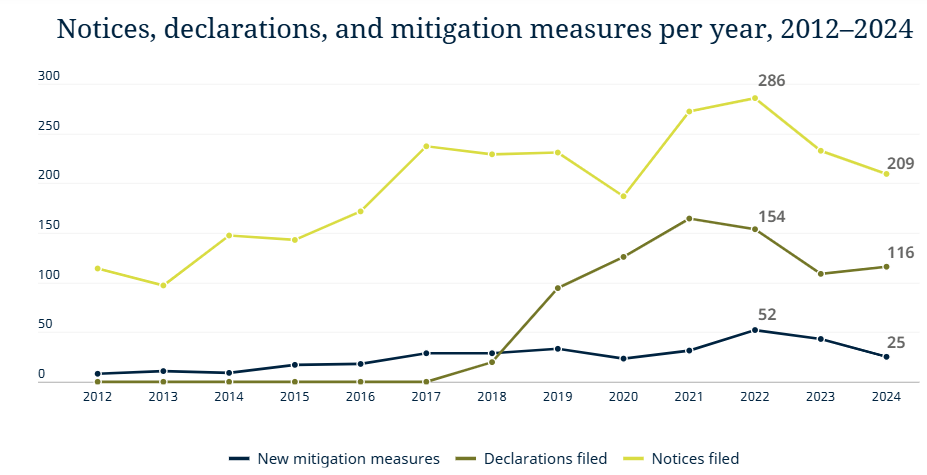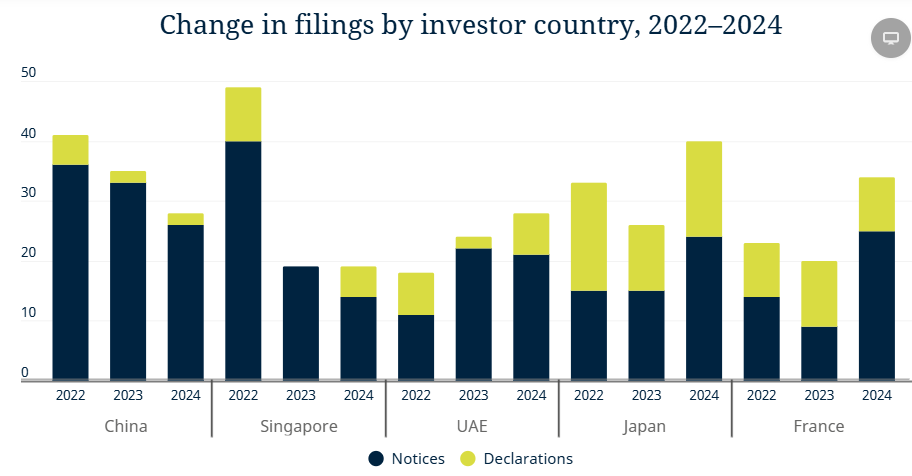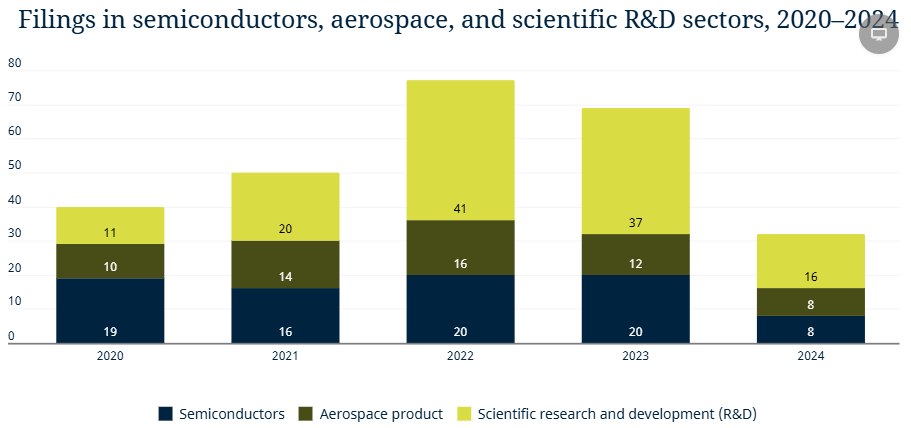[co-author: Melanie Tsang]
The Committee on Foreign Investment in the United States (CFIUS) released its 2024 Annual Report to Congress on August 6, 2025, outlining key trends in filings for the 2024 calendar year.
The 2024 Annual Report indicates a slight decline in the overall number of CFIUS filings compared to 2023, consistent with market trends during the same period. However, there was a significant uptick in enforcement activity and the imposition of penalties. The number of filings from investors in allied nations increased, and the rate at which declarations were cleared reached an all-time high. In contrast, there was a downward trend in filings from higher-risk jurisdictions, as well as in sectors such as semiconductors and scientific research and development (R&D).
These trends underscore an emerging pattern in which the CFIUS review process is increasingly shaped by geopolitical factors, resulting in a more pronounced distinction between trusted partners and higher-risk jurisdictions.
In 2024, CFIUS significantly increased site visits and intensified enforcement and compliance efforts against non-notified transactions and violations of mitigation agreements, underscoring the importance of early risk assessment and proactive engagement with CFIUS. These trends have continued into the 2025 filing year, and are reflected in the agenda of the Trump Administration’s America First Investment Policy published in February 2025, and described in our prior alert.
Below, we summarize the top five key takeaways from the 2024 Annual Report and considerations for investors in 2025 and beyond.
Key takeaways for dealmakers and investors in 2025
- 2024 marked a record year in CFIUS enforcement activity, with a surge in penalties and a steady rise in non-notified investigations and compliance site visits, reflecting CFIUS’s increasingly assertive use of its expanded oversight authorities.
- Early, robust CFIUS risk assessment is key, particularly for deals involving sensitive sectors, real estate, or investors from countries of concern.
- Mitigation may be less common, but it is more strictly enforced; compliance failures may result in unprecedented penalties and forced divestitures. Entities that promptly self-disclose violations and cooperate fully to remediate issues are more likely to receive leniency.
- Investors with a strong understanding of the CFIUS process and a track record of cooperative engagement are more likely to benefit from the Department of the Treasury’s recently announced known investor fast-track program.
1. Enforcement, investigations, and penalties reach record levels, backed by expanded CFIUS enforcement powers
2024 marked a record year for CFIUS enforcement action, reflecting a dramatic expansion of its investigative and compliance capabilities. CFIUS imposed five penalties totaling nearly USD88 million – including its largest-ever single penalty of USD60 million – which targeted violations including the failure to submit a mandatory filing, non-compliance with the conditions of a mitigation agreement (resulting in unauthorized access to protected data and delayed reporting), and material misstatements made in a CFIUS filing.
CFIUS publicly disclosed only six penalties prior to 2024, with USD1 million being the largest. Regulatory changes in 2024 further strengthened CFIUS’s enforcement capabilities, raising the maximum penalty per violation to USD5 million or, in some cases, the full value of the transaction, and broadening subpoena authority to compel information from third parties.
CFIUS also intensified its compliance monitoring and scrutiny of non-notified transactions. CFIUS investigated 98 potential non-notified deals and opened 76 formal inquiries, up from 60 inquiries in 2023. Despite the additional effort to identify non-notified transactions, CFIUS remains selective in requiring filings through this process, having requested filings for only 12 transactions through its non-notified process in 2024.
In 2024, CFIUS also identified, through its non-notification screening process, a transaction that it determined posed a risk to US national security and which ultimately received a divestment order. In May 2024, the MineOne group – a group ultimately owned by PRC nationals and operating cryptocurrency mining activities – was ordered to divest its real estate near a strategic missile base in Wyoming. More recently, in July 2025, President Donald Trump ordered Suirui Group Co., Ltd., a PRC company, to divest its 2020 acquisition of Jupiter Systems due to concerns over Chinese control of sensitive audiovisual technologies used in the US military and critical infrastructure. These actions underscore the risk of post-closing intervention for parties that choose not to voluntarily file and CFIUS’s robust enforcement posture for high-risk transactions. Together, they reinforce the importance of proactive CFIUS risk assessments, transparency, and engagement, particularly for investors from foreign adversary jurisdictions.
2. CFIUS filings remain resilient against broader market slowdown
Deal activity in the US slowed between 2023 and 2024, with mergers and acquisitions (M&A) deal activity declining by over 12 percent, and foreign direct investment in the US dropping by more than 14 percent, from USD176 to USD151 billion.[1] Consistent with broader market patterns, CFIUS filings saw a modest contraction: the Committee reviewed a total of 325 filings in 2024 – 209 full notices and 116 declarations – representing a 5-percent decrease in filings from 2023 and a 25-percent drop from the 2022 peak. After accounting for withdrawn and refiled notices and declarations that converted to full notices, the number of distinct transactions reviewed in 2024 was approximately 266, slightly lower than the 273 distinct transactions reviewed in 2023.

Figure 1. Raw data derived from CFIUS Annual Reports, 2012–2024. Declarations became available in 2018 with the implementation of the Foreign Investment Risk Review Modernization Act of 2018 (FIRRMA). Data reflects total filings as opposed to distinct transactions.
3. Record-high declaration clearance rates signal efficient processing of lower-risk transactions
Despite the overall decline in deal volume across the US in 2024, the number of declarations filed with CFIUS increased from 2023 to 2024, and a record 78 percent of declarations were cleared, up from 76 percent in 2023 and 58 percent in 2022. Considering the breakdown of declarations based on the country of investor, the majority of declarations filed in 2024 – 83.7 percent – involved investors from countries that are either North Atlantic Treaty Organization (NATO) allies or major non-NATO allies (MNNAs), a composition that is fairly consistent with previous years (80.8 percent in 2022, 77.5 percent in 2023). The increased declaration clearance rate appears to indicate the increasing effectiveness of the declaration process as a fast-track option for lower-risk transactions, particularly for those involving investors from allied countries.

Figure 2. Raw data derived from the 2024 Annual Report. Declarations became available in 2018 with the implementation of FIRRMA. These numbers reflect the declaration totals depicted in Table I-1 of the 2024 Annual Report.
The 2024 Annual Report also suggests a shift in the geographic composition of filings: foreign investors from China dominated CFIUS filings in 2022 and the years before, but filings have since declined for two consecutive years (an overall 27.78 percent decrease for China since 2022). This may reflect the effects of US regulatory deterrence against Chinese acquisitions of US technologies and a more challenging geopolitical environment for Chinese investors in the US. Total filings from investors in Singapore also dropped sharply by 65 percent since 2022.
Filings from investors in certain allied countries, including Japan and France, increased since 2023, despite the lower overall number of CFIUS filings. Notably,
- Japan had a total of 40 filings (up from 26 in 2023)
- French investors submitted 34 filings overall (a 70 percent increase from 20 filings in 2023)
Filings from investors in the UAE also increased in 2024 by 16 percent. Likewise, filings from investors in allied countries were more likely to be short-form declarations than filings from investors in China, which consisted almost exclusively of notices in 2024. This may indicate a continued trend in the bifurcation of CFIUS review tracks based on geopolitical affiliation, which is expected to continue based on the Trump Administration’s May 8, 2025 announcement of its planned CFIUS fast-track pilot program for trusted investors.

Figure 3. Raw data derived from CFIUS Annual Report 2024. The data by country reflects total count of investor countries represented in filings, not distinct transactions. The Report notes that the highest number of notices in 2024 were from investors from China, France, Japan, the UAE, and Singapore.
4. While filings in critical technologies remain consistent, filings in the semiconductor, aerospace, and scientific R&D sectors trend downward
Critical technology
Filings involving investments in US critical technology companies remained consistent from 2023 to 2024, both in absolute numbers and as a share of overall submissions. In 2024, CFIUS reviewed 150 such filings, including declarations and notices, which accounted for roughly 46 percent of the 325 total filings that year, compared with 153 filings representing about 45 percent of the total filings in 2023.[2] In 2024, investors from Japan, France, China, Germany, and the UAE were the most prevalent foreign investors in US critical technology.
While the 2024 Annual Report does not detail the specific critical technologies involved in each transaction, it provides a broad sectoral breakdown based on a three-digit North American Industry Classification System (NAICS) category, indicating the highest number of critical technology filings in the following sectors:
- Professional, Scientific, and Technical Services (46 filings)
- Computer and Electronic Product Manufacturing (22 filings)
- Fabricated Metal Product Manufacturing (15 filings)
- Machinery Manufacturing (13 filings)
- Transportation Equipment Manufacturing (11 filings)
Broader technology filing trends
The 2024 Annual Report more broadly notes that transactions involving the finance, information, and services sector accounted for 53 percent of CFIUS notices, of which the largest subsector, or 53 notices total, involved professional, scientific, and technical services.
Within this subsector, some of the larger filing categories in 2024 included:
- Computer Systems Design and Related Services (26 total notices, which may involve cybersecurity, AI, and other advanced computing technologies)
- Architectural, Engineering, and Related Services (10 notices, which may involve robotics and systems engineering)
- Scientific Research and Development Services (10 notices, a category which may be more likely to involve biotechnologies and sensitive data)
While filing volumes for any specific NAICS code or grouping of codes are relatively low and may not be representative of overall M&A trends, the Annual Report notes a decline from 2023–2024 in larger filing volumes in several sectors:
- Semiconductor and Other Electronic Component Manufacturing: down 60 percent (from 20 to 8 total filings)
- Scientific Research and Development: down 57 percent (from 37 to 16 total filings)
- Aerospace Product and Parts Manufacturing: down 33 percent (from 12 to 8 total filings)
Together, these shifts may indicate the deterrent effects of growing industry scrutiny and political concerns over foreign investments in advanced research and manufacturing. Such a deterrent, however, does not appear to have affected the volume of overall filings in critical technologies or technology services.

Figure 4. Raw data derived from CFIUS Annual Reports, 2020–2024, representing total filings across notices and declarations. Industries were reported to CFIUS using NAICS codes for semiconductor and other electronic component manufacturing (3344), aerospace product and parts manufacturing (3364), and scientific research and development (R&D) services (5417).
5. CFIUS imposes mitigation measures on fewer cases, but doubles down on compliance
CFIUS imposed mitigation measures on fewer transactions in 2024 than in previous years. This trend may continue with the Trump Administration’s more recently stated intent in its America First Investment Policy, to reduce “overly bureaucratic, complex, and open-ended” mitigation, while imposing tighter restrictions and greater scrutiny over foreign adversaries. CFIUS may continue to hone its use of mitigation agreements to target sensitive sectors and higher-risk investors.
Of the 206 total covered transaction notices filed in 2024, 12 percent (25 total) were cleared with mitigation, down from 18 percent in both 2022 and 2023. This shift from long-term, open-ended mitigation agreements may reflect a policy preference for more targeted, time-limited actions – and may also be a result of decreased filings from Chinese investors and in sensitive sectors such as semiconductors and scientific R&D. Despite fewer overall mitigated transactions in 2024, CFIUS significantly expanded its compliance efforts. Between 2023 and 2024, CFIUS nearly doubled its compliance site visits, conducting 79 visits in 2024, compared to 43 in 2023. CFIUS notes its visits involved in-depth interviews, records inspections, and verification of access controls.
Considerations for investors in 2025
The 2024 Annual Report outlines several developments that may inform the evolving landscape for foreign investment reviews, including a more differentiated review process with higher clearance levels for allied, low-risk investors, and greater scrutiny over transactions involving critical technologies or investments by foreign adversaries.
Recent enforcement actions underscore that geopolitical alignment alone may not insulate allied country investors from elevated CFIUS scrutiny. Investors may expect an increased likelihood of investigations and enforcement penalties for failing to submit mandatory filings, submitting false or incomplete filings, or for violations of mitigation agreements. Transparency and cooperation with CFIUS are essential for effective compliance.
Below, we highlight some larger considerations of the 2024 CFIUS Annual Report.
- Differentiated review process: Pursuant to the America First Investment Policy and the Trump Administration’s more recent announcement of its fast-track pilot program for known investors, investors could see a more differentiated CFIUS process, with streamlined, expedited reviews for allied and partner investors and high barriers for foreign adversary investors. The declaration process may continue to serve as an efficient process for low-risk deals, while higher-risk transactions could face more scrutiny and longer timelines.
- Sectoral and geographic realignment: Growth in the share of filings from allied countries, including for investments by sovereign wealth funds, and a further decline in the share of Chinese and other adversary country investments, may continue. Sectors such as AI, quantum, biotech, and advanced manufacturing may be focal points for review.
- Mitigation agreement trends: While the number of new transactions subject to mitigation measures declined in 2024, CFIUS may continue to hone its use of mitigation agreements to target sensitive sectors and high-risk investors. Compliance measures such as site visits, audits, and penalties for non-compliance are expected to remain a priority.
- Jurisdictional expansion: CFIUS jurisdiction is expected to increase, particularly in real estate and agriculture. The addition of new military installations and critical infrastructure sites to the real estate appendix could drive more filings in these areas. The US Department of Agriculture’s National Farm Security Action Plan may also increase scrutiny over transactions involving agriculture.
- Heightened non-notified transaction risk: CFIUS continues to devote more resources to identifying and reviewing closed transactions through its non-notified process. Transactions involving adversary countries or sensitive technologies, data, infrastructure, or real estate may face elevated risk of post-closing intervention.
[1] Data available at: https://www.statista.com/statistics/245977/number-of-munda-deals-in-the-united-states/ and https://www.bea.gov/news/2025/new-foreign-direct-investment-united-states-2024
[2] The 2024 Annual Report does not adjust critical technology filing counts to remove duplicate counts arising from refiled transactions or notices that originated as declarations.
[View source.]